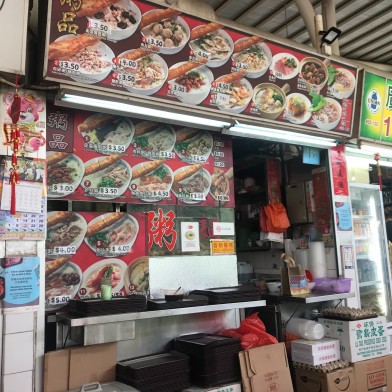Around the world, travel is starting to look more like it used to be pre-pandemic. Writer Rochelle Angus can confirm, having travelled between Singapore and Malaysia earlier this year on one of the world's busiest land crossings.
Recently I made the return trip from Singapore to the state of Johor in Malaysia, twice.
When we came to a standstill well before immigration for our second visit, it was quickly obvious this hadn’t been a unique idea. Turns out approximately 262,000 people crossed that day, making it the busiest day since reopening the border in April this year, CNA reported. In our excitement to dust off our passports and take the causeway off our little red dot, we’d completely forgotten it was local school holidays and looks like everyone was heading to Malaysia.
Prior to the pandemic over 300,000 people used the causeways daily, making this one of the world’s busiest land crossings. Most Malaysians coming into Singapore do so to work or study and are often commuting daily. Singaporeans, for their part, tend to visit Malaysia as tourists or to visit family. Johor is known for its shopping bargains and generally offering more bang for your Singapore dollar. Many of Singapore’s food imports such as poultry, fish, eggs, vegetables and milk are trucked across daily from Johor.
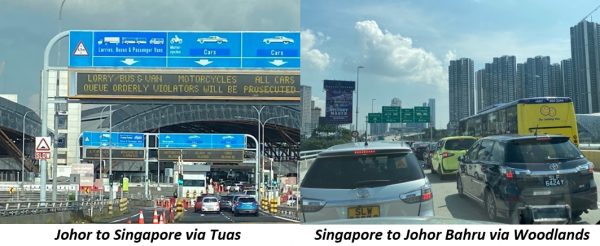
As for us, this was the closest we’d come to travel and adventure for three years. We didn’t need much of a reason. Passports at the ready and petrol tank three-quarters full (a requirement when leaving Singapore) we headed off. Tuas or the ‘second link’ is the newer and most of the time quicker of the causeways. You would cross here if driving to Malacca or Kuala Lumpur, visiting Legoland, the Premium Outlets or one of the two international schools nearby.
Our Tuas trip took an hour each way - it was smooth and stress-free. Coming back into Singapore the customs officer was chatty and as he checked our boot, we had a laugh about whether he was checking for chickens. Malaysia has currently stopped exports of all live chickens to Singapore, reportedly due to shortages in the domestic market. Thirty percent of Singapore’s imported chickens take the one-way trip across the causeways.
Heading into the city of Johor Bahru (known locally as JB), we took the Woodlands Causeway for our second trip two days later. Long known for its congestion issues, we look forward to the reopening of the shuttle train, and the not-too-distant future when the Rapid Transit System is completed. For today, we just thought, “how bad can it be at 10.30 am on a Wednesday”? One hour was our starting ETA, but three-and-a-half hours was our reality. Traffic was completely backed up for the 2.4 kilometres between the two checkpoints. It wasn’t ideal.
Often overlooked as the ‘cheap and cheerful’ neighbour, or the gateway to more interesting destinations in Malaysia, we didn’t have any set plans or expectations for this visit. The first thing that always hit me when arriving in JB, is that it’s busier, noisy and generally more chaotic, or at least feels that way. The cars are no longer all shiny and new, and there are motorbikes and scooters everywhere – that’s on the roads and on the footpaths. GPS or not, coming into the city, you can spend a lot of time going in circles (as we did) getting to where you are going. The old and new look to all be jumbled together. Where Singapore tends to restore or replace, Johor has the space to just add more.
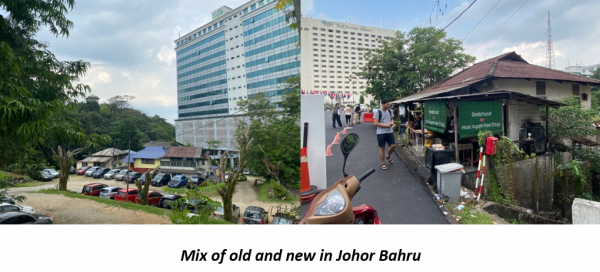
Malay is the official language although English is widely spoken, and the population is predominantly Muslim. This is reflected in the prevalence of mosques and halal eateries throughout the country. As we jalan-jalan-ed (walked) around, we came across the old town and Tan Hiok Nee Heritage Street where the Chinese influence could be seen. In the early stages of gentrification, the shophouses are home to some funky cafes, shops and galleries. The majority though look like they probably have for the last century and are in definite need of a paint job.
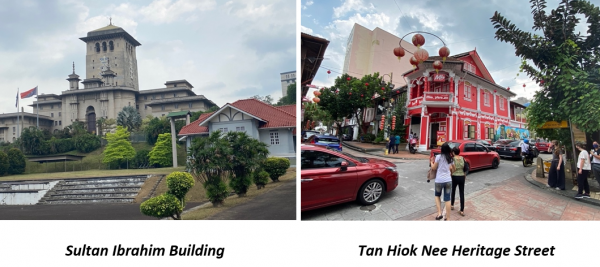
Two of the shops which haven’t changed in the last century and are known for their traditional wood fire ovens are Hiap Joo Bakery and Salahuddin Bakery. We couldn’t resist buying the ‘famous’ banana bread at Hiap Joo – still steaming with the top open when it arrived. $4 was a bargain! We brought enough for the whole neighbourhood. Salahuddin is now in its fourth generation. We were served by the youngest of the family, and grandad was out the back cooking. Here we stocked up on potato curry puffs, curry and coconut buns, and kaya (coconut jam). All for much cheaper than Singapore.
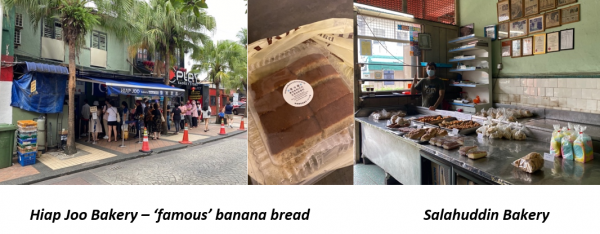
With 90 percent of the population not drinking alcohol, you can work hard to find a cold beer at times. Luckily for us, it seems no matter where you are in the world, you are never too far from an Irish pub. We enjoyed our beer just as the afternoon rain rolled in, and it was the perfect end to a fun day. Excited by our brief foray back into travel, by the time we were home – a respectable one hour later – we’d already planned our next Malaysian road trip to Malacca. We’ll take the second link this time!
- Asia Media Centre
